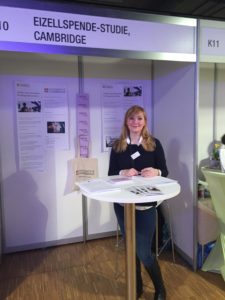Germans travelling abroad for an egg donation – transparency versus anonymity
“I do not understand why egg donations are prohibited in Germany, while sperm donations are permitted […] They always say that they want us to have more children, but then they ignore women like me who would like to have a child, but cannot do so without an egg donation. […] I just think it’s unfair […] I do not even ask for money, we simply just want permission […] I do not understand, why, if we pay for it ourselves, is this not a legitimate way to become a mother in Germany?”
Elisabeth, 42, planning to have an egg donation abroad
Egg donation remains criminalised in Germany (Embryo Protection Act, 1990). The justification for this prohibition is that egg donations are thought to “divide motherhood”, which is considered to be “to the detriment of the child’s well-being” (German Medical Association, 1998). As a consequence of this law, an increasing number of Germans like Elisabeth travel abroad every year in order to receive fertility treatment in the form of egg donations in countries where these are allowed.
My research project will investigate what this legal prohibition means for German couples travelling abroad for an egg donation. The study will be based on in-depth interviews with German policy makers, reproductive clinicians and Germans who travel abroad for egg donations.
Why are egg donations prohibited in Germany?
Egg donations are prohibited according to the German Embryo Protection Act. Policy makers in the 1980s were concerned that an egg donation would result in a so-called “division of motherhood”, which would harm the child’s well-being. What is meant by the division of motherhood? It refers to there being ‘two’ biological mothers – one genetic and one gestational mother.
The justification for this prohibition is that egg cell donations are thought to “divide motherhood”, which is considered to be “to the detriment of the child’s well-being” and is believed to “inhibit the child’s healthy self-development”(German Medical Association 1996).
This idea of ‘divided motherhood’ only exists in the German cultural context.
It will thus be a guiding theme of my thesis to unpack this idea, trace it, follow it.
What is the consequence of this prohibition?
The German Embryo Protection Act (EPA, 1991) prohibits the medical act of facilitating an egg donation, however, it does not punish the woman who receives another woman’s egg cell.
As such, a German woman who undergoes the egg donation treatment abroad will not be punished for this.
Consequently, a few thousand Germans travel abroad every year in order to receive egg donations, mostly to Spain, the Czech Republic and Austria.
Defying the German law – Guiding themes & research questions
I will discuss how an understanding of German ideas of transparency and the perceived need to protect the right of the (unborn) child have informed the ways in which German national legislation regulates gamete donation today.
Such a discussion further lends itself to an analysis of a series of questions, such as:
What does it mean for the egg donor conceived child, if it does not have the same rights as the sperm donated child, what implications does this have when conceptualisation national ideas of motherhood vs. fatherhood?
What can the concept of transparency tell us about German ideas of the significance of reproductive (genetic) origin?
Short recap – what others have said on reproductive travelling
There is a limited number of qualitative and ethnographic studies that have advanced our understanding of decision-making processes in the context of reproductive travel globally (for example, Inhorn 1994, 2015; Gurtin 2011; Pfeffer 2011; Nahmann 2013), but very few in the German context (Bergman 2010, Bergman 2012).
Indeed, there is no study on Germans travelling to another German-speaking country for egg cell donations. As such, my work will make a contribution to fill this gap.
Existing literature includes Marcia Inhorn’s work on reproductive travelling (1994; 2011; 2015), in which she uses the idea of the ‘fertility journey’, which will be highly useful for my own research. In Marcia’s first book Quest for Conception (1994), she makes an implicit analogy between the quest for a child and a pilgrimage.
What is interesting about this concept of pilgrimage is that it is not about getting to a point, but really it is about the state of mind, of being on the journey. The book pertinently raises questions, such as, what does it mean to go on a fertility journey? And what does wanting a child mean phenomenologically?
As Sarah Franklin (1997) demonstrates, the pursuit of having a child can to a certain extent fulfil the goal of having a child itself. This is because while you are on that journey toward parenthood you are more aligned with other parents; even if they are not having a baby, you can still be baby-focused.
What is the value of the research?
As Franklin also points out that there is not a good language for how people describe this kind of agency, how they describe the justification of their behaviour (of travelling abroad for fertility treatment) and the moral basis for it.
Part of my task in my research will thus be to characterise these subjective and affective dimensions of a fertility journey.
In this research I see the potential to name, describe and analyse a specific kind of fertility journey that also has more generalisable implications.
Methods – How I go about
To find interviewees for my project, I have set up a website www.eispende.com (German only). It describes the study, its aim and what will happen in the interview in detail. I share the website on social media, internet forums etc.
I am also attending public events in Germany that revolve around reproductive technologies. For example, I had a stall at the first German fertility show in Berlin in February 2017, where about 15 people signed up to be interviewed.
Finally, I have a cooperation with fertility clinics that help me get in touch with Germans who travel abroad for egg donations.

Intrigued?
To learn more about the study and who can participate, go to www.eispende.com (German only).
Here you can learn more about who I am.
Questions, feedback, ideas? Drop me an email at yiif2 (at) cam.ac.uk.
References
Bergman, S. ‘Reproductive agency and projects: Germans searching for egg donation in Spain and the Czech Republic’. Reproductive BioMedicine Online, Volume 23 , Issue 5 , 600 – 608.
Franklin S. 1997. Embodied Progress: A Cultural Account of Assisted Conception. London: Routledge
Franklin, S. and Lock, M. 2003. Remaking Life and Death: Toward an Anthropology of the Biosciences. Oxford: John Murray.
German Medical Association [Bundesärztekammer]. 1998. ‘Richtlinien zur Nutzung von assistierten Technologien’ [Guidelines by the German Mecial Association for new assisted reproductive technologies]. Available online https://www.kvbb.de/fileadmin/kvbb/dam/praxis/qualitaet/genehmigungspflichtige%20leistungen/kuenstliche_befruchtung/kuenstbefrucht_pdf. accessed 3-5-2016
Inhorn, M. 1994. Quest for Conception. Philadelphia: University of Pennsylvania Press.
Inhorn, M., 2011. ‘Diasporic dreaming: return reproductive tourism to the Middle East’. Reprod. Biomed. Online 23, 582–592.
Inhorn, M. 2015. Cosmopolitan conceptions: IVF sojourns in global Dubai. Durham: Duke University Press.
EPA, Embryo Protection Act [Embryonenschutzgesetz]. 1991. Available online http://www.auswaertiges-amt.de/cae/servlet/contentblob/480804/publicationFile/5162/EmbryoProtectionAct.pdf accessed on 1/1/2016.
[1] www.ots.at/presseaussendung/OTS_20160929_OTS0143/legalisierung-der-eizellspende-boom-in-oesterreich-und-grosse-nachfrage-aus-deutschland-bild 12/11/2016







